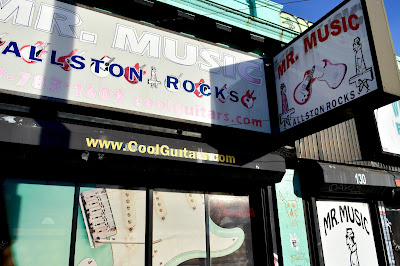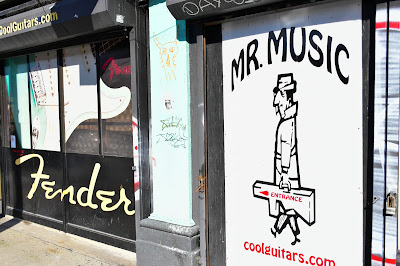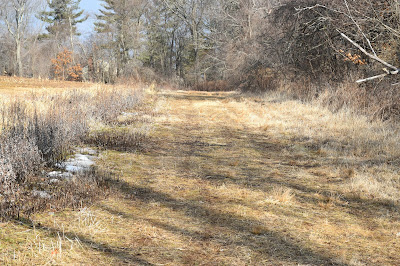From Dave Brigham:

The first place I lived when I moved to Boston in the fall of 1990 was an apartment in Brighton. During the three years my girlfriend (now wife) and I lived in that neighborhood, we frequented bars and clubs in neighboring Allston. I saw some great bands at Bunratty's, which eventually became the Melody Lounge and then Local 186 and then Wonder Bar and then empty. Another favorite hangout was the Kinvara Pub, where the soundtrack was heavily loaded with Irish/Scottish bands, from U2 and the Waterboys to Thin Lizzy and the Pogues.
In this first of four posts about Allston, I'll talk about those and other locations, and bands I saw there, as well as all sorts of other rock 'n' roll-type stuff I saw on my return to Allston Rock City.
I'm going to start at a more recently deceased club: Great Scott.

(Entrance to the former Great Scott, which had an awning over it.)
Opened in 1976 (replacing a joint called Brandy's), the club closed in May 2020 due to, you guessed it, coronavirus-induced economic hardship. Since that time, the owners have been working to resurrect Great Scott. There was an effort to relocate a few blocks away to the former Regina Pizzeria location in a former train depot, but that hasn't borne fruit. Here's hoping they succeed in these difficult times when COVID, redevelopment and a changing social scene are conspiring against them.

(Electrical box outside the former club, showing the aforementioned awning.)
Great Scott in its early days was a blues and folk club. From 2005 to 2020, however, this club on the corner of Commonwealth and Harvard avenues served up punk, indie and folk rock night after night after night. I saw bands including Giant Sand and the Neal Pollack Invasion here. My buddy Jay of Arlington, Mass.-based Clicky Clicky Blog used to host his annual shindig here, featuring loads of local bands, such as Speedy Ortiz, Guillermo Sexo and Soccer Mom.
The two best shows I saw at Great Scott were both in 2012: Japan's groundbreaking pop-punk band Shonen Knife, and U.K. indie rockers Johnny Foreigner (another great show put on by my buddy Jay).
(Shonen Knife at Great Scott in July 2012.)
(Johnny Foreigner at Great Scott in November 2012.)

(Cool mural on the back wall of the former Great Scott.)

(I peeked through these windows. The floors have been stripped out. Not sure what might go in here.)
Head north across the very busy four lanes of Commonwealth Avenue (as well as two sets of trolley tracks), and in short time you'll find yourself in front of a vacant space at 186 Harvard Ave., where I hung out on occasion alongside grungy rockers, leather-clad badasses, jocks, nerds and, once, a bunch of fake-British fops.

This, ladies and germs, is where Bunratty's (et al) once stood. 'Twas here that I saw bands such as Antietam, a band of Kentucky transplants who landed in Hoboken, New Jersey, in the early '80s (check out "War is (the health of the state)," the first song I ever heard by this band); Dinosaur Jr., an Amherst, Mass.-based band that proffers wonderfully sludgy slabs of rock (check out "The Lung"); and the Upper Crust, the aforementioned dandies, who sound like AC/DC and dress like French royalty circa 1782 (for your listening pleasure, "Let Them Eat Rock").
Let's face it, the odds of another rock club taking over 186 Harvard Avenue are lower than the chances of The Rat clawing its way back to its old dingy, dirty home in Kenmore Square now that Eastern Standard has shut its doors. In April 2021, the Boston Licensing Board granted the owners of the Wonder Bar the right to transfer a liquor license to a placed called Han at 186 Harvard Avenue. So in the near future, I assume, we'll see what's been going on behind the plywood.

(Wile E. Coyote hanging out on the plywood covering the old Bunratty's space.)
As for building itself, it's got a cool history. Erected in 1920, the building was originally a vaudeville theater, according to this great article at the Music Museum of New England web site. The site was a moviehouse for a short time, as well. In 1969, Dennis Mullins opened Bunratty's, named after an Irish castle that I visited in August 2018.

(Bunratty Castle)
"In it’s (sic) heyday, and for well over a decade, the venue hosted two to four bands a night: seven days a week; three hundred and sixty five days a year," the Music Museum article states. Like many rock clubs of that era, Bunratty's (known fondly as Bunz) could be more than a little scuzzy. But it was always a fun place to hang out. While reading that article, though, I learned that on one occasion it was a deadly place. "In August 1987, roller-skating doorman Abel Harris, a well liked kid, was murdered by an angry patron and Dennis sold the bar to his girlfriend and accountant Lorraine Curtis the next year; in 1988. The night Abel was shot the metal band Bang was playing and many people in the packed place thought the loud noise of the gun fire was a part of their show."
Holy smokes, I never heard about that. Anyway, in the ensuing decades the place changed hands and names and the music became tamer. I recall hearing people refer to Wonder Bar as a "fern bar." Wonder Bar closed in November 2020 due to, you guessed it, COVID-related shit.
A little further into the maelstrom of Harvard Avenue is Mr. Music, which has been selling guitars, ukeleles, keyboards and other equipment for 58 years.



I have a vague memory of walking into Mr. Music many years ago, probably not long after I first moved to Boston. I was looking to buy a guitar. I don't recall whether I just browsed, or tried a few out. The primary image in my head is a German shepherd sitting quietly in the corner. I never felt threatened, but I definitely found it odd.
Watch this video for a peek inside this place, which seems pretty great.
Looming behind Mr. Music is the former Allston Storage Warehouse/Yellowbrick Storage, which dates to 1915.



This massive space is now home to Studio 52, which features both band rehearsal and artist spaces.
Below is Studio 52's former location on Everett Street in Allston. It sits on the edge of a major redevelopment project, so I'm guessing it will be torn down at some point.

Continuing northward on our Harvard Avenue rock 'n' roll trek, we come to the former home of Common Ground.

Opened in the mid-'90s, this bar and restaurant also featured bands and DJ's over the years. The place closed in 2019 after nearly a quarter-century in business. The space is now home to Kao BBQ.
I think I was only here once, in the mid- to late-'90s, to see a Boston band called the Push Stars. Somebody my wife knew was friends with a member of the band, I think. They scored a song on the soundtrack of "There's Something About Mary," and put out a few major-label records, but have been on hiatus for many years.
Near the northern terminus of Harvard Avenue is where the Kinvara Pub once stood. It's been home to The Draft Bar and Grill for quite a few years.

The building dates to 1928, according to the Boston assessor's office. The Kinvara was operated by the Briar Group, which runs several restaurants, including City Bar in Boston's Back Bay; Gather, in the Seaport; Hurricane's at the TD Garden; and Six String Grille & Stage at Patriot Place in Foxborough.
Two doors down from the Draft, tucked down an alleyway and located in the basement of a former firehouse, is a Boston institution: Looney Tunes.



(It's crazy how many signs this store has!)
Run by a guy named Pat for the last 40 years, Looney Tunes is one of several Boston-area record stores still kicking after decades in business (Nuggets, Stereo Jack's, In Your Ear). Originally located on Massachusetts Avenue, and then Boylston Street, the store has been in business since 1978. Pat acquired the shop in 1982, according to this 2017 Boston Hassle interview. Judging from the interview, and from what I've heard from friends who know him, Pat is quite the character. As to why he bought the store, he answered: "I am in no way suited for regular fucking employment. I cannot contain myself sufficient to be part of anything that will require me to contain myself. This is expansive. There is an infinite variety of music for one thing, and there’s nobody to tell me to shut up."
Across the street from Looney Tunes is O'Brien's Pub, which has been around a long time. I'm ashamed to admit I've only been there once or twice. Once again, I owe that to my buddy Jay who put on a show there. Among the acts I saw on stage that night was Elizabeth Colour Wheel. They rocked, even after the lead singer somehow suffered a cut to hear head and was bleeding.

My buddy Jay wrote a great piece about them at his late, lamented blog. Read it.
(Elizabeth Colour Wheel, live in the studio.)
Next door to O'Brien's is Stingray Body Art, which isn't a club or record store, but is obviously a place where local rockers go to get inked and pierced. A college buddy of mine who has played in a million Boston bands over the last quarter century used to work at Stingray, before setting out on his own, with Bird in Hand Tattoo.

Another of the few venues for live music still left in Allston Rock City is Brighton Music Hall.

Why isn't this small (capacity: 500) club called Allston Music Hall? I don't know. This place has been in business for about a decade. The last show I saw before the pandemic was here: Battles.
It went like this:
For 40 years prior to the opening of the club, this space was known as Harpers Ferry (likely named after the West Virginia town known best for the raid that John Brown conducted on its armory in 1859). The club was known for a long time as a blues and R&B spot. According to Wikipedia, the club hosted a yearly blues festival and a a Battle of the Blues Bands.
Other types of music thrived there as well. "Harpers Ferry had a reputation throughout the Boston area as being an important venue in the hardcore music scene," according to Wikipedia. "After the closure of The Rathskeller, a famous venue in Kenmore Square, many of the hardcore bands that called The Rat home moved to The Middle East in the Central Square scene in Cambridge...or to Harpers Ferry....The WBCN Rock & Roll Rumble was held at Harpers Ferry in 2007 and 2008....On March 17, 2007, Dropkick Murphys performed their [annual] St. Patrick's Day show at Harpers Ferry."
Harpers Ferry closed in 2010 in light of a dispute between the club and its landlord. Other bands I've seen here over the years, both at Brighton Music Hall and Harper's Ferry, inlcude X, the Scud Mountain Boys, Susan Tedeschi (before the Tedeschi Trucks Band) and Mr. Airplane Man.
What's the most rock 'n' roll place in Allston? Is it the Model Cafe? Or the Silhouette Cocktail Lounge?

Opened in 1932, when it catered to workers in local factories, as well as truck drivers going in and out of those plants, the Model is only a bar now, but it used to be a full-service restaurant, according to this Boston Eater article.

I've never been to the Model. Judging from the photo above, it seems that the cafe added basic food during the pandemic, when establishments that were straight-up bars had to close for quite a while. This is where rockers hang out when they're not rocking.
There used to be a cool neon sign above the doorway; I'm not sure what happened to it.
As for the Silhouette, it's considered one of the best dive bars in Boston.

If nothing else, this place wins the "best signs" contest. I've never been here either. From what I understand, the clientele is a mix of old-time locals and college students. Last October, the 79-year-old owner, Joseph Eliseo, announced his intention to sell the bar to a venture that's been buying up other dive bars in recent years.

The mural on the side and back of the cocktail lounge is called The Famous Joes (in honor of Eliseo, I presume), and was completed by the Mayor's Mural Crew in 2006. From left to right, Pesci, Frazier, Piscopo, Cook (I think) Perry and Bazooka.
That wraps up the stuff that's directly related to this neighborhood's Allston Rock City moniker. Let's move along to some other stuff.
Allston Billiards has been in this location along Cambridge Street, above a body shop, for several years.


I'm not sure if this is a private club. I like that it's here; there aren't many pool halls left in the area.
Alright, let's finish up with some signs.
I dig the Blanchards Wine & Spirits sign along Harvard Avenue.

The liquor retailer was established in 1838 in Boston's Scollay Square. In 1938, the company was bought by John Corey who "grew the company from one retail location into a chain [of] retail stores," according to the Blanchards web site. "He also opened a distilled spirits plant and import division in the 1950’s located in Boston’s Historic South End." The company operates six retail stores in Greater Boston. Third- and fourth-generation Coreys continue to operate the business. Do those words look familiar? If you're a regular reader, they should. I wrote them about another Blanchards outlet, in Jamaica Plain (see January 22, 2022, "Jamaica Plain, Part I: Shopping & Snapping").
As for this Blanchards, I can give you some advice: If you're gonna be out and about in Allston late at night, don't park here. A million years ago, my girlfriend (now wife) and I parked here while out at the Kinvara, and when we returned to the lot, our car was gone. It had been towed to a lot somewhere south of Timbuktu. We had to take a cab to free our car. Pain in the ass, especially late on a long night.
I dig the sign advertising Kimchipapi Kitchen, which has been in business since 2018.

It's a Korean resaurant, but I'm not sure if the image is supposed to be Kim Jong-un or not. Owner Joon Son previously owned a sneaker shop, At the Buzzer, at this location. His mother, Ho Jeo Son, is a Boston restaurant veteran, having run Wuchon House in Somerville for years, according to Kimchipapi's web site.
Now for a sign of a different sort, for a much older business.

Arcand Sales & Service / Suspension Specialists, Inc. has been in business since 1908. At its founding, "we were primarily a blacksmith shop specializing in springs and suspensions on Carriages and Coaches. We worked on any transport vehicle, motorized or horse drawn," per the company's web site. It's still run by the Arcand family.
Lastly, the most well-known sign in Allston:


Located across North Beacon Street from The Model Cafe, Twin Donuts has been making donuts and coffee (and other foods) since 1959. I've found differing accounts about the age of this building -- 1920, says the Boston assessor's office, the 1800s, according to this profile on the Boston University web site. While the author of the BU article indicates the donut shop was "formerly occupied by the Odd Fellows Hall, a local movie theater," that's not correct. According to this Brighton Allston Historical Society article, the Odd Fellows Hall was located behind where Twin Donuts now stands, on a site where currently are situated a Dunkin' shop, a KFC restaurant and an auto service station. That information is borne out by these photos at a different location on the BAHS web site. Those pictures indicated previous tenants of 501 Cambridge Street include Commonwealth Lunch and Greene Druggist.
OK, that does it for the first installment about Allston. Make sure to check back soon for posts about houses of worship, ghost signs, apartment buildings and inns, a former train station, retail/restaurant space, murals, graffiti and much more. In the next post, I will talk at length about redevelopment, both projects that have already risen, and the many more yet to come.


































